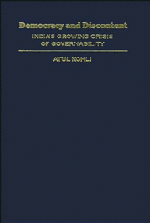Book contents
- Frontmatter
- Contents
- List of tables and figures
- Preface and acknowledgments
- PART I INTRODUCTION
- PART II THE GROWING PROBLEMS OF GOVERNING THE PERIPHERY: POLITICS IN THE DISTRICTS
- PART III ORDER AND BREAKDOWN IN THE STATES
- Introduction: the states
- 8 Breakdown in a “backward” state: Bihar
- 9 Growing turmoil in an “advanced” state: Gujarat
- 10 From breakdown to order: West Bengal
- Conclusion: the states
- PART IV CENTRALIZATION AND POWERLESSNESS AT THE CENTER
- PART V FINAL INFERENCES
- Bibliography
- Index
9 - Growing turmoil in an “advanced” state: Gujarat
Published online by Cambridge University Press: 05 June 2012
- Frontmatter
- Contents
- List of tables and figures
- Preface and acknowledgments
- PART I INTRODUCTION
- PART II THE GROWING PROBLEMS OF GOVERNING THE PERIPHERY: POLITICS IN THE DISTRICTS
- PART III ORDER AND BREAKDOWN IN THE STATES
- Introduction: the states
- 8 Breakdown in a “backward” state: Bihar
- 9 Growing turmoil in an “advanced” state: Gujarat
- 10 From breakdown to order: West Bengal
- Conclusion: the states
- PART IV CENTRALIZATION AND POWERLESSNESS AT THE CENTER
- PART V FINAL INFERENCES
- Bibliography
- Index
Summary
Gujarat is one of India's more prosperous states. Both governmental and political processes in Gujarat used to be relatively stable, but that stability became tenuous in the early 1970s. Violence as a tool to effect political change was rare in the 1970s, but that changed in the 1980s. In 1981, and again in 1985, politics in Gujarat came to be characterized by riots, arson, and other kinds of planned violence, and there was a growing sense that the state's capacity to govern had declined sharply. Whereas the dominant image of Gujarat politics in the 1960s was one of gentility, growing conflict and turmoil characterized the 1980s.
What happened? An answer is developed in this chapter by focusing on the political events of the 1980s. The answer has several components. The main issue, introduced in Chapter 3, and widely recognized in the literature, has to do with the growing caste conflict between the two major communities in Gujarat: the Patidars and the Kshatriyas. As the socioeconomic elite in the area, the Patidars traditionally have commanded both political power and relatively high status in the caste hierarchy. By contrast, most of the Kshatriyas are lower in the socioeconomic hierarchy, but they are a significant numerical force. Over time, Kshatriyas leaders forged an alliance with other disadvantaged groups, won elections, and gradually pushed the Patidars out of government. As the new leaders sought to use state power to alter the old patterns of socioeconomic privilege, the Patidars countered with strong resistance, unleashing violence in the state.
- Type
- Chapter
- Information
- Democracy and DiscontentIndia's Growing Crisis of Governability, pp. 238 - 266Publisher: Cambridge University PressPrint publication year: 1991



